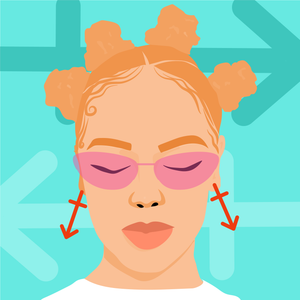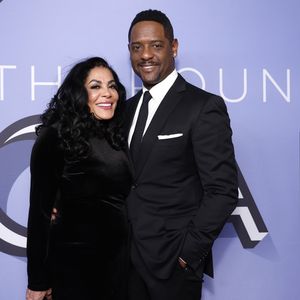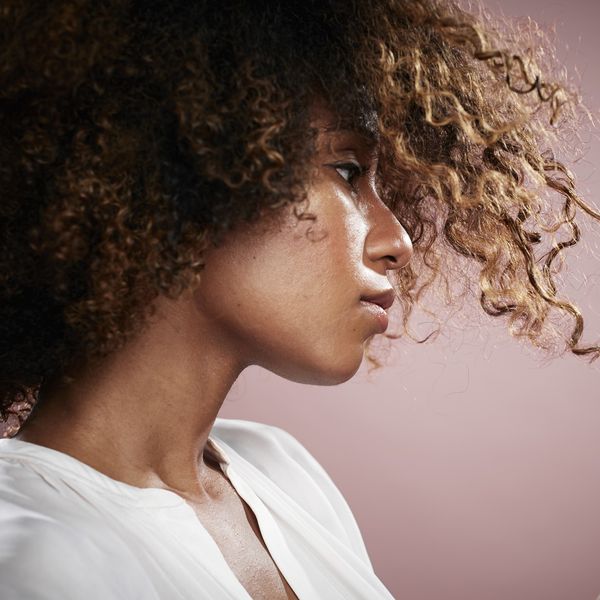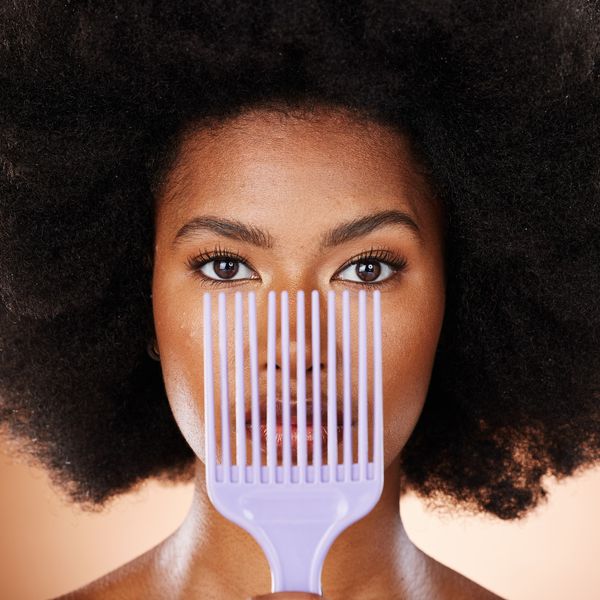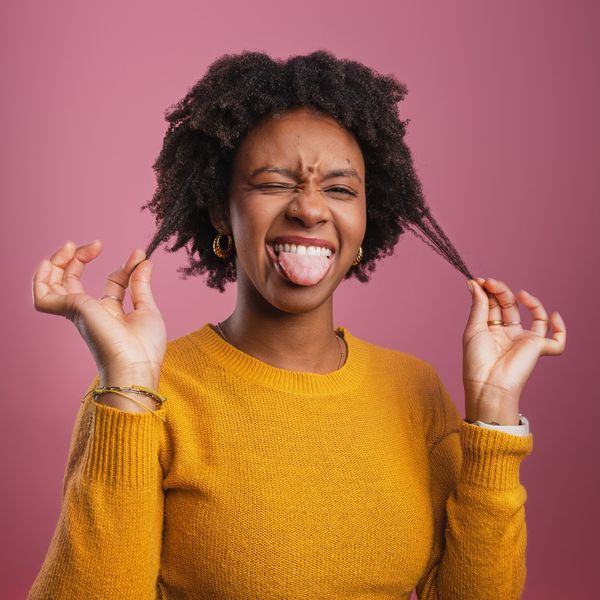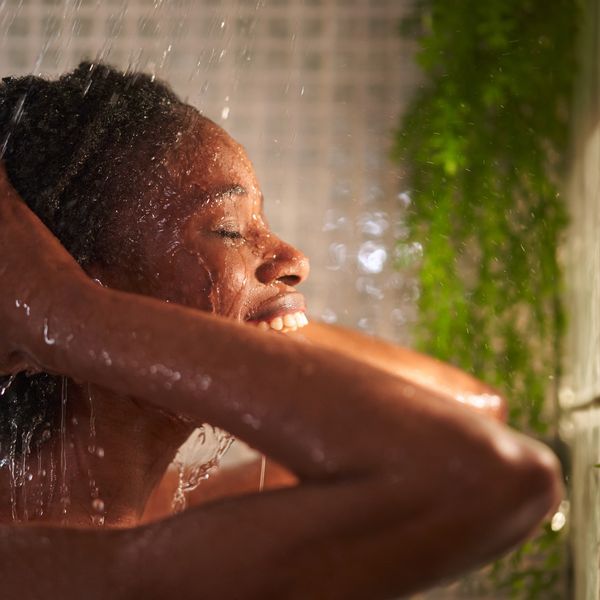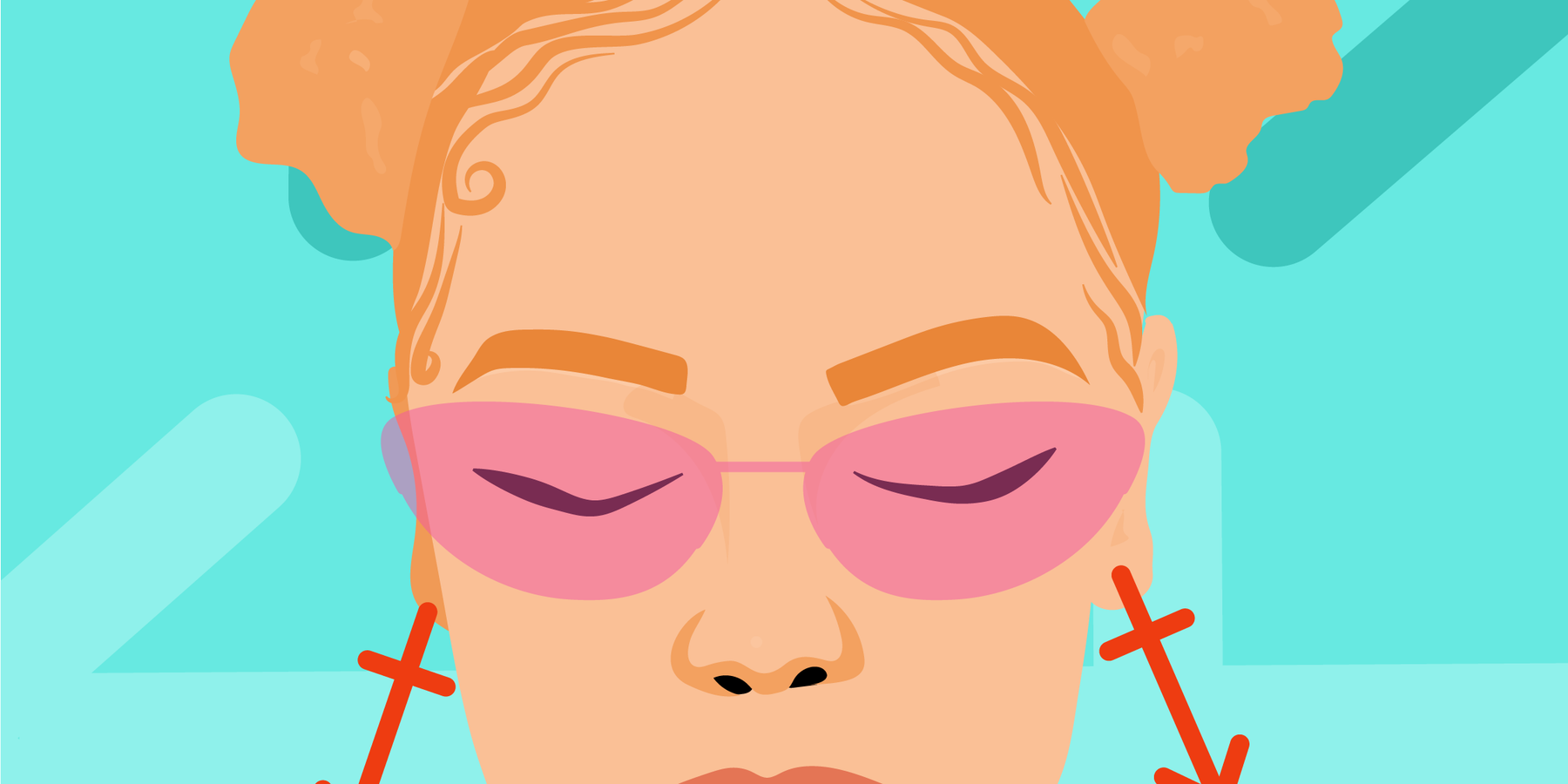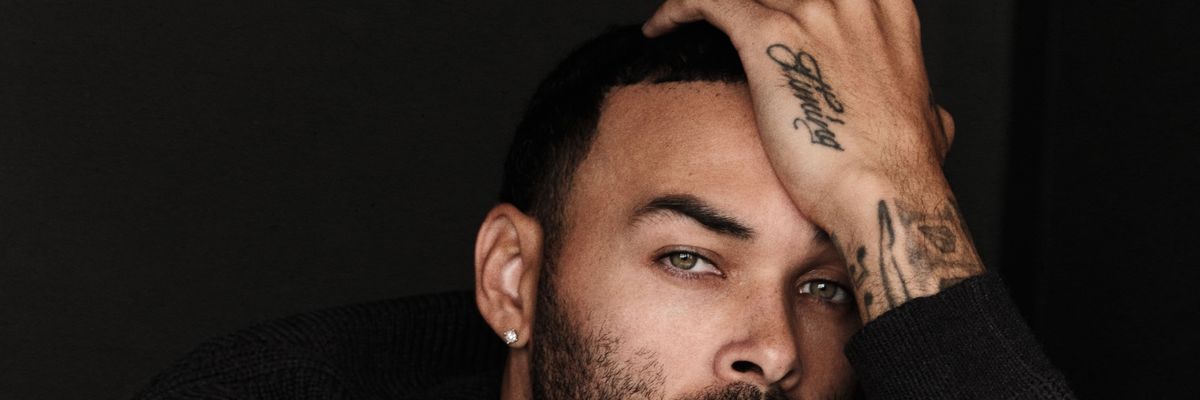
It's kinda crazy what inspired me to pitch and then pen this article. I was watching Usher's visual for "Bad Habits" while trying to figure out why a particular small area of my hair was thinner than it needed to be. I came to the conclusion that it was because I was manipulating it too much by always taking that particular cornrow down and braiding it up again. And that got me to thinking about so many of the bad natural hair habits that a lot of us have; ones that prevent us from getting the long-term hair results that we want.
If you're sick of your own tresses not flourishing as much as you would like, take a moment to see if any of these habits are ones that you definitely need to break.
1. Keeping Your Protective Style in Longer Than You Should
I don't know one naturalista who hasn't heard that one of the best ways to achieve length retention is by putting their hair up in a protective style. As I said a second ago, my hair is currently in cornrows (a personal favorite style of choice). I dig them because, not only do they keep me from having my hands in my tresses all of the time, but protective styles are also a great way to protect my ends as well (damaged ends are the main reason why most of us don't get the inches that we want). Still, too much of a good thing can easily work against you.
In this case, if you've got your hair in some braids or twists (via your natural hair), they really need to remain in there for no longer than a couple of weeks. Braids and twists with extensions, you're pushing it if you keep them in for longer than two months. The reason why is because your hair and scalp need to be thoroughly washed and to take a break from the stress that protective styles can cause if you've got them in for too long. One day, I'm gonna share how protective styles can actually be the reason why your hair isn't growing. For now, though, just don't keep them in for a billion years. It's the kind of bad habit that doesn't get discussed, nearly enough.
2. Using Too Many Damn Products in Your Hair
The beauty industry is a billion-dollar one and we as Black women play a HUGE role in why that is the case. That said, I know there are tons of products out here that make all sorts of promises. But you've gotta remember that companies are looking to make revenue. This means that if they've gotta lie to you and say they have a serum that will fix your split ends (nothing fixes split ends; you have to trim them), that is exactly what they will do.
Anyway, while I'm all about finding products that work best for your hair if you use a lot of them at the same time or you keep switching up, all that's gonna do is either weigh your hair down and clog up your hair follicles (not good) or end up damaging your hair because not all products are created equal and your hair shouldn't be treated as some guinea pig or science project. It typically takes about two months to figure out if something is really your jam on the product testing tip. Try a couple of things out at a time and stick to what works for you, even if it's only a few products. Less is more is always best when it comes to hair care.
3. Not Knowing Your Hair Type and Texture
Let me tell it, I think women struggle with knowing what their hair type is about as much as they struggle with figuring out their correct bra size. When it comes to hair type, the numbers run from 1-4. 1 is straight. 2 is wavy. 3 is curly and 4 is coily. Then there are letters that go with each number, ranging from A-C. A is fine. B is medium. C is coarse. As far as your "numbers" go, YouTubers like Angela C. Styles, IAMTRAEH, and LavishlyBritt all have videos that break hair types down pretty well. As far as your hair's texture, a cool figuring-it-out hack is to take a piece of thread and lay it on a flat surface. Then place a strand of your own hair beside it. If your hair appears thinner than the thread, your hair is fine. If it's the same size, your hair is medium. If it's bigger, it's coarser.
Having this information is essential because it can help you to better understand how to properly care for your hair, what products work best, and ultimately how to keep it thriving. For some tips on all of these things, go to YouTube and put your hair type and texture, along with "natural hair" in the search field and you will see literal days' worth of videos pop up so that you can get to know your hair, even better.
4. Using the “Wrong” Styling Tools for Your Natural Hair
A lot of stylists will tell you that using your hands to detangle and style your hair as much as possible is oftentimes a good look because you can be gentler with your locks than you can with styling tools. But when it comes to the things that you absolutely do need, make sure you've got—a wide-tooth comb; some plastic hair clips (the metal ones tend to snag and tear); a Denman brush; a hair steamer (to lock in moisture); a microfiber towel (it's easier on your hair during wash days) and a blow dryer for your hair type (Red by Kiss Blow Dryer gets a lot of praise if you're a 4-type).
While this is a basic list, the main thing to keep in mind is a lot of metal, a ton of heat or anything that will cause your hair to snag and tear are absolutely no-nos. You really don't need a ton of styling tools; just things that will make getting the results that you want as easy as possible without creating any drama in the process on those pretty tresses of yours.
5. Mishandling Wet Hair During Wash Days
Your hair is definitely the most fragile when it's wet. That's why it's best to detangle your tresses with your fingers as much as possible, to deep condition after shampooing so that your hair is more manageable, and to apply a product that has some "slip" to it when you're using a detangling comb or you're doing something like braiding or twisting your hair for a braid out or twist out. Otherwise, you could end up ripping some of your hair out or weakening the cuticles during the styling process. As far as slip goes, if you'd like a little help figuring out which product would work best, Naturally Curly gave some slip awards to a few. You can check them out here.
6. Trimming Your Hair More than Dusting
One of the reasons why I stopped going to see a professional stylist was because far too many of them don't seem to know the difference between dusting and trimming. Hmph. I've always wondered if a lot of stylists have a secret vendetta against their clients gaining inches because I don't always need a bob— thank you, very much. Whew. Plus, as I've learned more about what does and doesn't work for my hair, I've become a big fan of dusting. Dusting is about getting rid of the raggedy or split ends that you may have without getting rid of 2-4 inches of hair in the process.
If you're nervous about attempting this, the main thing to keep in mind is you need a pair of sharp shears and a good amount of patience. Click here, here and here to watch some videos on how to dust.
Oh, and for any stylists that may have side-eyed me for what I said, I know there are some great ones out there and that some folks wouldn't be able to walk outta the house without one. At the same time, I believe a good one also isn't scissor happy. I'm thinking that we all can agree on that.
7. Having a Complex Relationship with Heat
Contrary to popular belief, I personally don't think that heat is the enemy; I think using heat the wrong way is, though. Back when I got on board with the whole "heat is the devil" movement, I actually experienced a lot more breakage than I do now that I blow my hair out every wash day and then leave it in a protective style (other than the weekends) until the next wash day. I believe it's because this method stretches out my hair so that there is less tangling and it also helps me to nurture my ends easier.
Anyway, that's not to say that huge mistakes aren't oftentimes made in this lane, mostly because people use the wrong kind of heating tools, apply them when they're too hot and/or use them too often. If you're in search of a good blow dryer for your natural hair, Byrdie recently published an article that features 12 (click here). After getting one, always make sure that your blow dryer is on low-to-medium heat and that you ONLY use it once your hair is about 60 percent dry on its own (the drier it is, the less you will be able to singe it). And try not to apply heat more than 2-5 times a month. More than that can definitely damage your hair and even alter your natural curl pattern.
8. Being High-Maintenance with Your Edges
Lawd, the internet. I'm pretty sure some of y'all saw the post of the young lady who mistook Gorilla Snot (which is already quite a beast when it comes to laying hair down) for Gorilla Glue. Well, at the time that I'm writing this, her hair literally hasn't moved in a month. Like…at all which resulted in her going to the ER (check her take on it here and a radio interview with her here). When I watched the video, the first thing that came to my mind is how obsessed a lot of us are with keeping our edges as laid as possible.
Listen, there's no time to get into how I believe that European culture has played a certain role in us having a preoccupation with baby hairs as grown women (goodness). For now, I'll just say that probably the most fragile parts of your hair are your edges and nape. So, constantly weakening your edges' hair follicles by always brushing them down, drying that part of your hair out with gels, and always applying pressure with braids, lace fronts and wigs are all surefire ways for your edges to either thin out or bald altogether.
If you must gel those babies down, make sure to use a non-alcohol gel (Allure published a feature on some of the best edge controls around; check it out here) and definitely give that area a break a few days a week. Sleek edges are cool, but you know what's even better? Having edges, period.
9. Jacking Up Your Wash ‘N Go
When it comes to low-manipulation hairstyles, wash 'n gos always top the list because you don't have to do a lot of styling and touching of your tresses in order to end up with a really cute look. That doesn't mean that too much of a good thing can't go awry though. The wrong products, tugging too much on your hair while it's wet and not knowing how to cultivate a bedtime routine that will result in you messing with your hair as little as possible the following morning all have to be factored in to make this a good idea for your natural hair texture.
If you want to make sure that this heat-free look goes off without a hitch—wash your hair with a sulfate-free shampoo; deep condition your locks; rinse your hair in cool water (it will keep your cuticles smooth); apply a curl cream (if you've got tighter coils) or add a carrier oil as a base to it (if you've got a looser curl texture) to set your curls, and keep your hands COMPLETELY out of your hair until your tresses dry (otherwise, you could end up with a significant amount of frizz). Wrap your hair up with a silk scarf or satin bonnet at night and refresh in the morning with a light leave-in conditioner. And try and let your wash 'n go be for about a week. Remember, low manipulation is always the key to stronger hair. You can get some other wash 'n go hacks by checking out this video, this video, this video, this video and this video.
10. Being Too Reliant on Your Wigs
Wigs can be dope; especially the kind that exists these days because I promise you that some, I can't even tell that they are wigs at all (like this line right here). Not only can wigs help you to avoid over-manipulating your hair, but they can also protect your tresses from outer elements, encourage your styling creativity without a lot of drama, and save you a ton of time when it comes to your morning routine.
Just remember that a wig is not your natural hair (no matter how much it may look or feel like it). If you've got a human hair well-secured, it can last for up to six weeks (if you take care of your natural hair that's underneath); just don't go beyond that. As far as sleeping in wigs, it really is best to remove them. If you opt not to, don't go more than a few days without doing so. Your hair and scalp need to breathe. Your edges need a bit of a break from the stress and tension of the wig too.
11. Not Taking a Multivitamin
There is plenty of data that says most of us don't get nearly enough nutrients from food alone. This is where multivitamins come in. They are a great way to supplement what you may be lacking which can result in everything from a strengthened immune system and healthier heart to more energy and beautiful hair, skin and nails. There are loads of vitamins on the market, so it's kind of hard to recommend a specific brand. You might want to look for one that specifically says "for hair, skin and nails" on it. Whatever you do, just make sure there are vitamins A, B12, C and E, iron, biotin and zinc in the product that you decide to go with. One that contains collagen is definitely a bonus. Oh, and if you opt for a liquid form, not only does it hit your system faster, it tends to be more potent too.
12. Stressing Out
If there is one thing that I have learned to become more and more intentional about, it's not letting any person, place, thing or idea stress me out. It's just not worth it. PERIOD. This includes when it comes to protecting my hair. Did you know that constant stress can throw off your cortisol levels and literally push your hair into a resting phase that can hinder it from growing? No joke. So, if you've got some job or man who is driving you up the wall and you're noticing some shedding or even thinning as far as your hair is concerned, don't tell yourself that it's all in your head. There is a very real chance that you are going bald due to anxiety. Release what's got you in that state. Your hair will thank you for it.
BONUS: STOP COMPARING
Iyanla Vanzant once said, "Comparing yourself to others is an act of violence against your authentic self." Out of all of the mistakes that we could possibly make when it comes to our hair, I promise you that the biggest one is comparing your tresses to someone else's. When God made you, he took out just as much time as he did on his other daughters. Don't insult him by acting like you somehow got a shorter end of the deal because, I can say from very personal experience, that once you get a real understanding of how your own hair works, you'll come to adore its individuality. You really will.
You'll wake up knowing that your hair is a gift, that there isn't one thing wrong with it, and that you are truly blessed. That your Creator made not one mistake. Amen? Amen.
Featured image by Giphy
- How To Determine Your Hair Type - xoNecole: Women's Interest, Love, Wellness, Beauty ›
- Protective Styles Not Working - xoNecole: Women's Interest, Love, Wellness, Beauty ›
- Taking Care Of Your Natural Hair While Traveling - xoNecole: Women's Interest, Love, Wellness, Beauty ›
- Tracee Ellis Ross' 'Hair Tales' Is About More Than Hair - xoNecole: Women's Interest, Love, Wellness, Beauty ›
- Pattern Beauty Blow Dryer Review Tracee Ellis Ross - xoNecole: Women's Interest, Love, Wellness, Beauty ›
Your December 2025 Monthly Horoscopes Are All About Surrender & Alignment
December is about letting go. We end the year with the need for more peace, reflection, and rejuvenation, and that is exactly what December is providing for us. The Sun is in Sagittarius, and anything is possible. This is the month to believe in that and to know that the universe is supporting you. With a Supermoon in Gemini as we begin the month as well, we have an opportunity to gain the closure we have been looking for this year and to wrap up old projects, ideas, and communication breakthroughs.
This is the month to make your peace the priority and let go of trying to control the way the tides are turning. Trust in your new beginning, and give yourself time to prepare for it this month.
A big part of the clarity that is coming through this month is due to Neptune going direct in Pisces on December 10, after being retrograde here since July. With Neptune now direct, we are able to see our inspiration and creativity a little more clearly, providing the perfect energy for dreams and manifestation to be built upon. The smoke is clearing, and it’s up to you to decide what you want to do with this newfound clarity that this transit is bringing. Mercury also moves back into Sagittarius on December 11, which is great for communication and clarity, and the adventures you were trying to see through at the beginning of November come around for you again with greater purpose and support.
On December 15, Mars enters Capricorn until the end of January 2026, and this is the extra push we need to make important changes and to be on the path towards greater abundance, stability, and prosperity. Mars in Capricorn takes care of business, and we have extra energy at our disposal during this time to do so. This transit is an ideal time to focus on your career or financial goals for next year and to start putting some of these plans into motion now. A few days later, we have the New Moon of the month, which will be in Sagittarius on December 19, and this is the perfect New Moon to manifest.
The energy is high, magic is in the air, and it’s all about moving forward with the new beginnings that are inspiring you and bringing you joy to think about right now.
Capricorn Season officially begins on December 21, and this earth sign energy is how we heal, gain closure, and build new foundations in our world. With Venus also moving into a Capricorn a few days later, there is something about peace, prosperity, and security that we are gaining in life and in love as we close out the year, and this is what we need right now. This month is about reflecting on what was, letting go of old hurt, and renewing. December is an ending and a new beginning in one, and there is magic in this space to be created.
Read for your sun and rising sign below to see what December 2025 has in store for you.
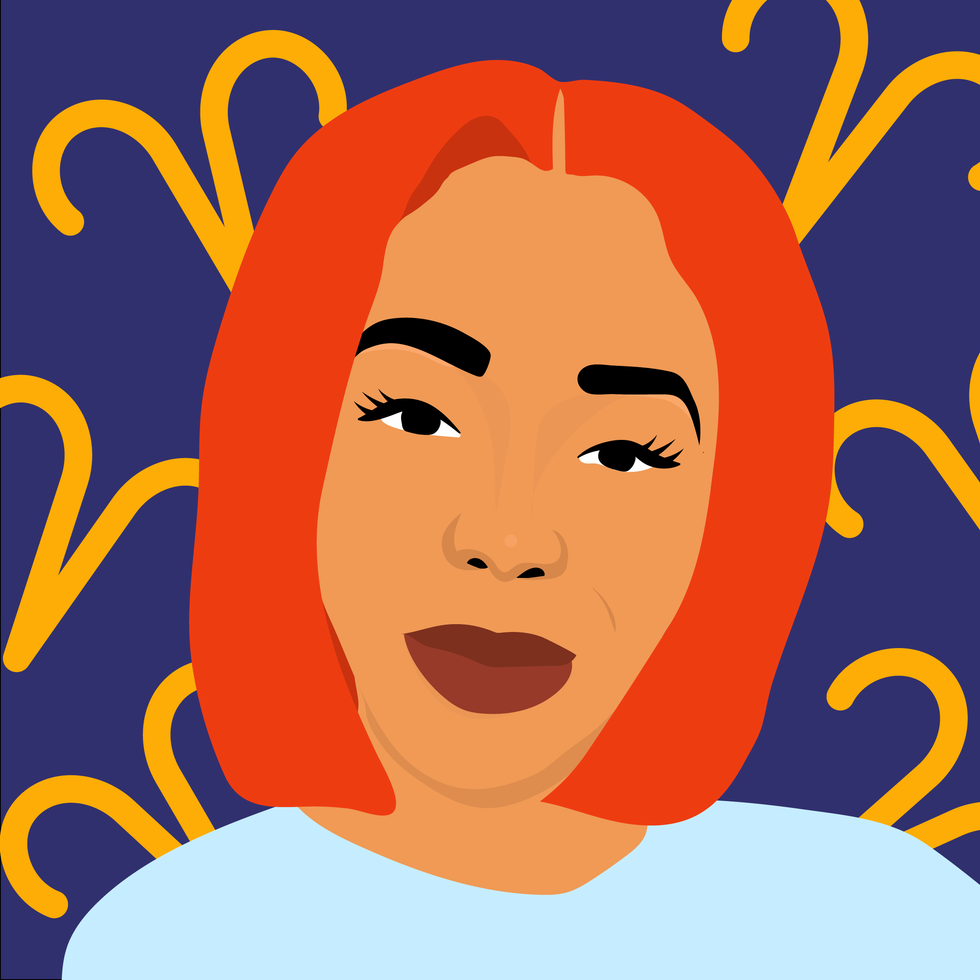 AriesKyra Jay for xoNecole
AriesKyra Jay for xoNecoleARIES
December is a full-circle moment for you, Aries. You are seeing the gifts in your world and have a lot of gratitude for the way things have come about for you as of late. There are culminations in your world that are providing you with more abundance, stability, and community, and you are exactly where you are meant to be this month. With the Sun in a fellow fire sign and in your 9th house of travel for most of the month, December is a good time to get out of your comfort zone, explore the world around you, and get your body moving.
Mars, your ruling planet, also makes a change and moves into Capricorn on December 15, which will fuel your inspiration and power in your career space. You are making a lot of professional progress as we close out the year; however, make sure to be more mindful of your competitive drive right now. The New Moon on December 19 is the perfect opportunity for you to create some new plans and goals when it comes to traveling, education, and where you want to gain some new inspiration in your world. Overall, this is a month of things coming together for you serendipitously.
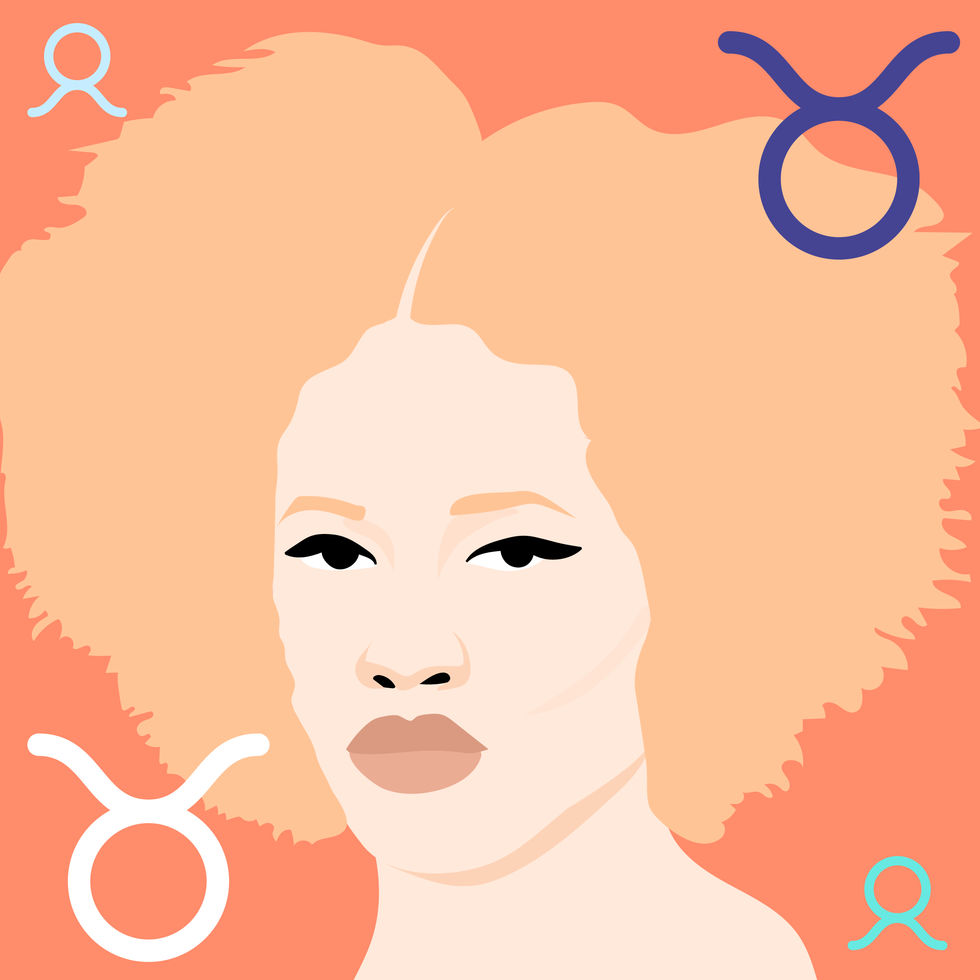 TaurusKyra Jay for xoNecole
TaurusKyra Jay for xoNecoleTAURUS
December is about trusting your intuition, Taurus. You have a lot on your mind this month, and it’s best to delegate, communicate, and allow yourself some relief by opening up to someone and not feeling like you have to hold everything in. As we begin the month, we have a Supermoon in Gemini happening in your house of income, and the plans and projects you have been building here come to fruition for you now. This is the time to gain clarity on your financial world and to take a look at what spending habits you want to let go of here as well.
With Venus in your 8th house of shared resources for most of the month, you are doing a cleanse on your commitments, partnerships, and business ventures. You are taking a look at what you want to dedicate yourself to in the future, and what commitments you may need to let go of now in order to be in the space you truly want to be, both financially and within some of your relationship dynamics. Before we end the month, we have a New Moon in this same area of your chart, and it’s time to look at the opportunities that are presenting themselves and to trust your internal guidance system to lead you forward.
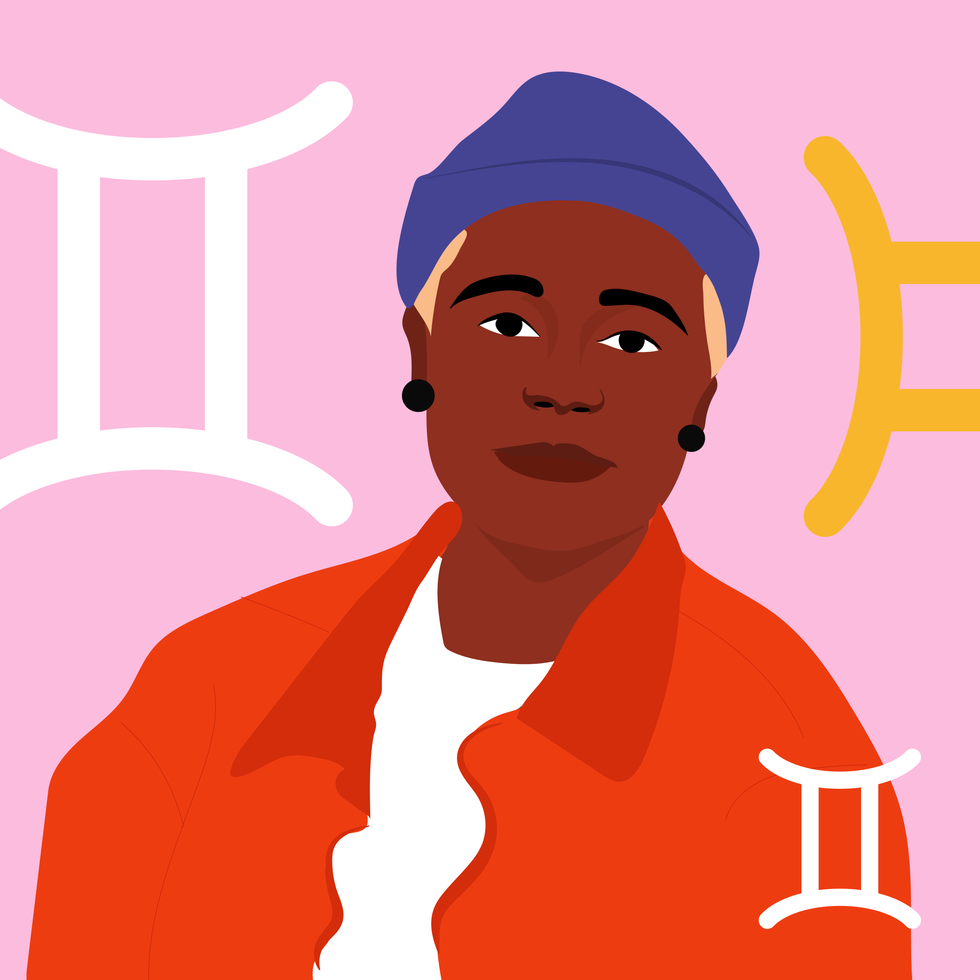 GeminiKyra Jay for xoNecole
GeminiKyra Jay for xoNecoleGEMINI
You are moving forward fearlessly this month, Gemini. December is your month of love, passion, and dignity, and you are owning the light that you shine. We begin the month with the last Supermoon of the year, happening in your sign, and you are stepping up to the plate. You are showing up, owning how much you have grown this year, and allowing yourself to heal while also acknowledging that you have done your best and you deserve to have fun in the midst of the changes you are creating.
Mercury, your ruling planet, is officially out of retrograde, and you can use this energy to the fullest potential now. With Mercury in your 7th house of love, it’s time to speak from the heart and to talk about the things that matter and that are inspiring you right now to your loved ones. You never know what kind of epiphanies you may have when you open up the conversation to others. Before the month ends, you have a New Moon in this same love area of your chart, and this New Moon is all about manifesting romance, commitment, and abundance in your world.
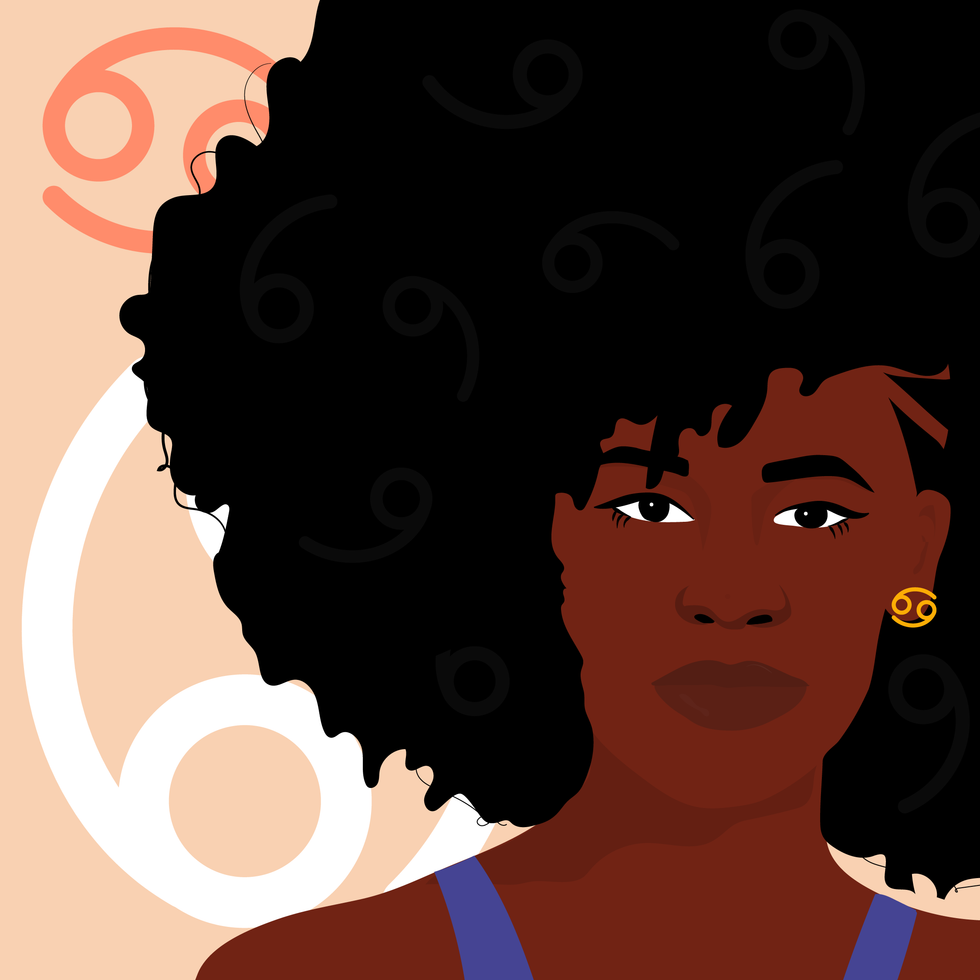 CancerKyra Jay for xoNecole
CancerKyra Jay for xoNecoleCANCER
December is an opening for more love, more joy, and more freedom in your life, Cancer. You have come to a place where you hold so much gratitude in your heart for where you are today and where your heart is shining, and things come together for you with more ease right now. With the Sun in your 6th house of health, work, and daily routines for most of the month, you are getting your ducks in a row while also putting more energy and effort into taking care of yourself, your priorities, and your well-being. This month surprises you in many ways, and it’s because you are showing up.
Mars and Venus both move into your house of love, relationships, marriage, and abundance this month, and you are making strides in your love life. You have both of these opposing forces on your side and are being recognized for the love you are while also receiving the love you want. This month, overall, is about focusing more on the positives in your world and letting your heart have its joy. Before December comes to an end, there is a New Moon in Sagittarius, and this is the perfect opportunity to create the plans you want to see through next year, especially when it comes to your work life, colleagues, business ventures, and health.
 LeoKyra Jay for xoNecole
LeoKyra Jay for xoNecoleLEO
The scales of karma are balancing, and they are balancing in your favor this month, Leo. December is your month of truth, and of seeing it clearly in your world. The Sun is in your house of romance, pleasure, and happiness for most of the month, and it’s time to relax, be in the present moment, and allow what is meant to be, to be. With a Supermoon in your 11th house of manifestation as December begins, this is a powerful month for seeing your dreams come to fruition, and for feeling like the intentions you have set this year are finally here for you now.
Mars also moves into your 6th house mid-month, and this is the perfect energy to have to move into the new year. You have extra energy at your disposal right now and are feeling fearless with what is possible for you and your daily routine. Before the month ends, we also have a New Moon in a fellow fire sign, Sagittarius, and this is a breakthrough moment for you and your heart. December, overall, wants to show you how loved and supported you are and will be doing so in magical, unexpected, and concrete ways.
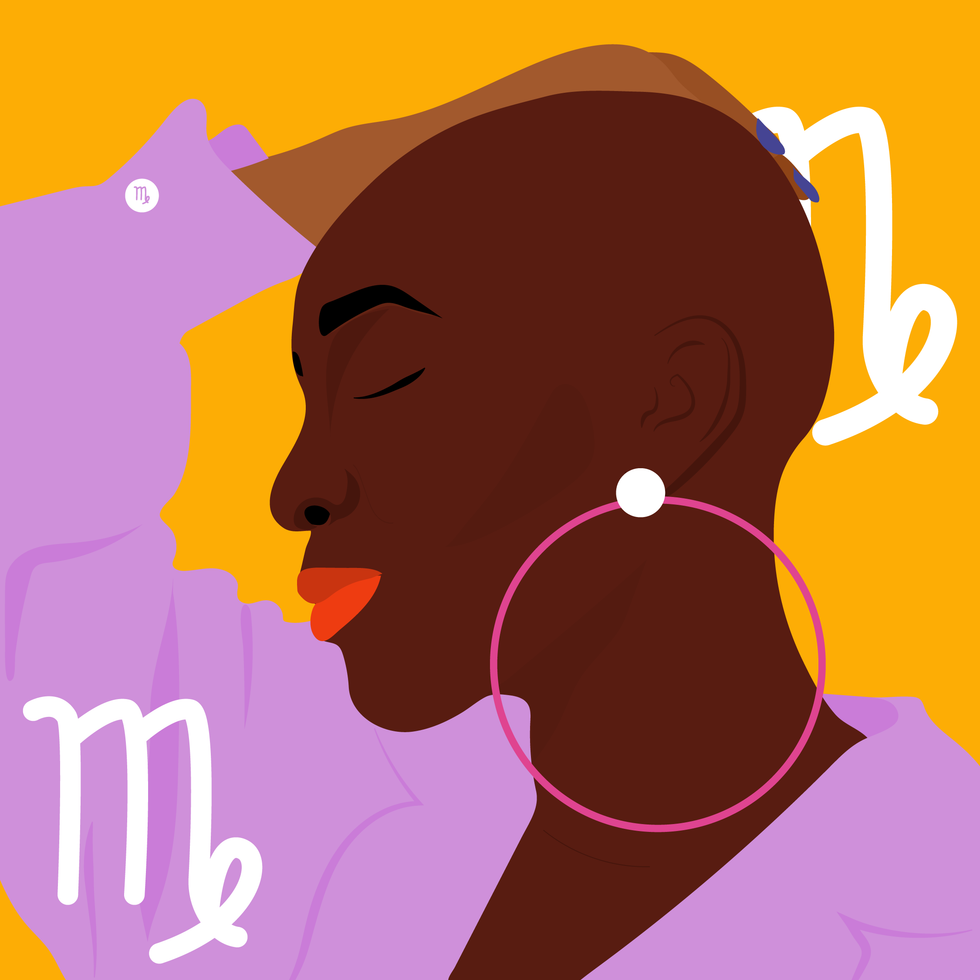 VirgoKyra Jay for xoNecole
VirgoKyra Jay for xoNecoleVIRGO
December is a month of victory, Virgo. You are showing up and experiencing some new successes in your world that move you forward on your path in life. With a Supermoon in your 10th house of career as we begin the month, the effort and intentions you have made this year come into full bloom, and you are being recognized for who you are and the good work you have done. This month is all about showing up and allowing yourself to be seen and loved, knowing that you deserve the support and opportunities you are receiving.
Mars moves into Capricorn on December 15, which brings the passion and excitement into your love life, hobbies, and little pleasures in life that light you up. You want to have fun this month and are going to be walking into the new year with this fearless, happy, and spontaneous energy within you. Before the month ends, Venus also enters Capricorn, and in this same area of your chart, you have a lot to look forward to and believe in right now. Overall, December wants you to be happy and will be doing everything possible to make that happen for you. This is your month to shine, Virgo.
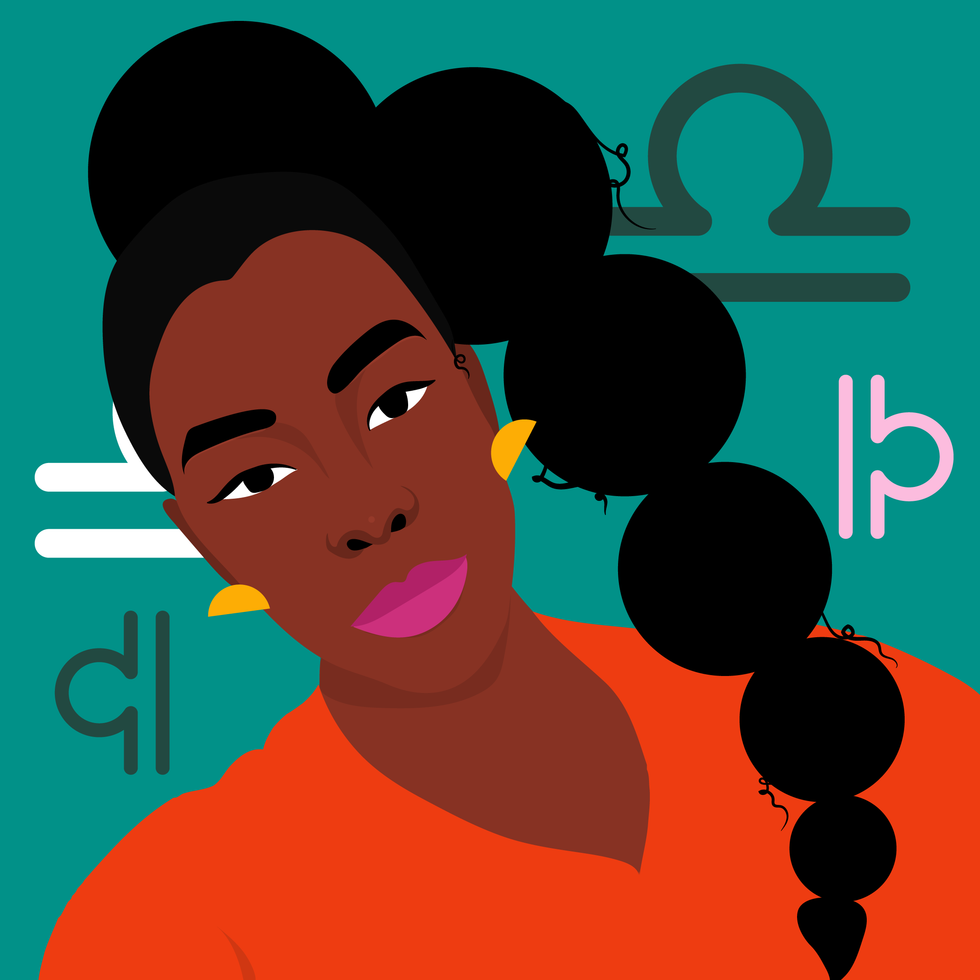 LibraKyra Jay for xoNecole
LibraKyra Jay for xoNecoleLIBRA
December is a month of opportunity for you, Libra. New doors open, and you are financially making breakthroughs this month because of it. December begins with a Supermoon in your 9th house, and you are getting a clearer view of where you have been making strides in your life and how it has all brought you here to this present moment of freedom. This month is showing you what happens when you are fearless with your purpose and when you believe in yourself and what you are worthy of.
Moving further into December, Mars moves into your 4th house of home and family mid-month, and you are closing out the year in your safe spaces. You are spending more time with your loved ones and taking the time to quiet your mind and listen to what your heart has been telling you. Before the month ends, we have a New Moon in Sagittarius, happening in an area of your life that deals with communication. This is a great time for getting the answers you have been looking for and for feeling more clear-headed and confident about the decisions you are making as you move into the new year.
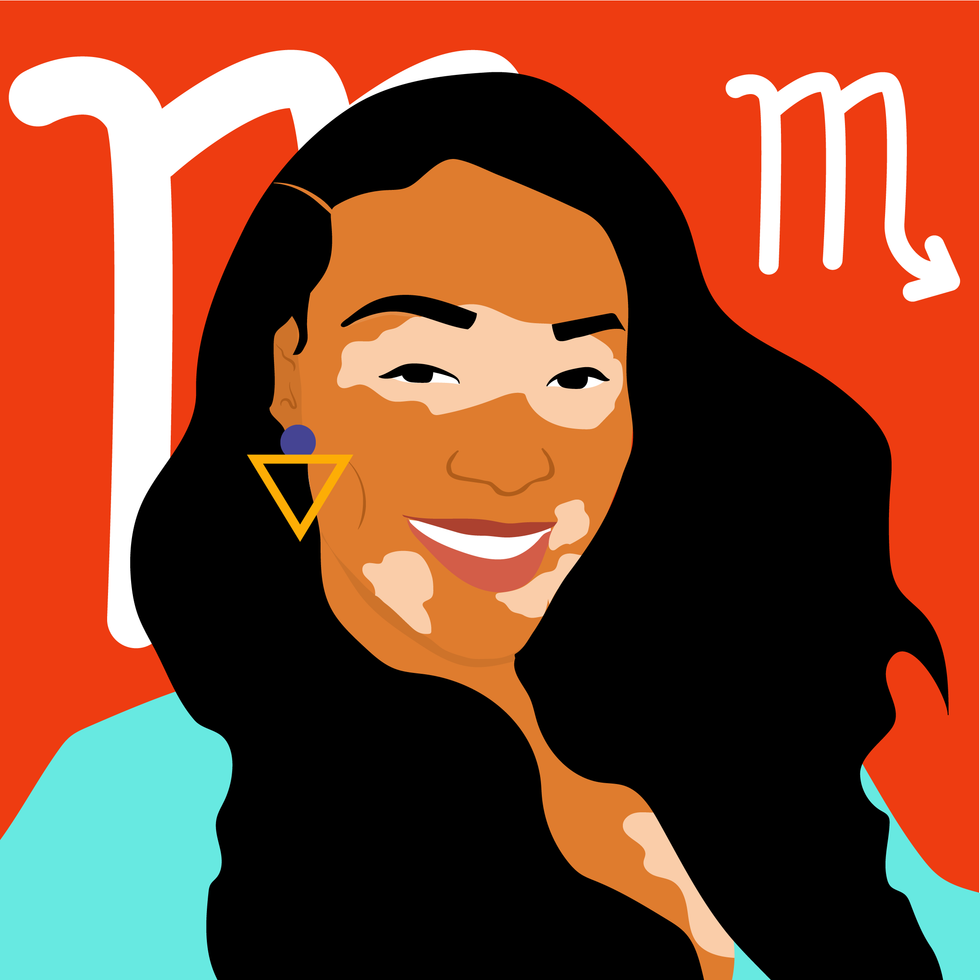 ScorpioKyra Jay for xoNecole
ScorpioKyra Jay for xoNecoleSCORPIO
Patience is a virtue this month, Scorpio. December is all about remaining patient and vigilant with what you are creating in your world, and knowing that the universe has your back. It’s time to be reminded of the power of hope, and this month is an opening to greater clarity in your life. There is a lot of energy in your financial zones right now, and this is providing you with new opportunities and new insight; however, the speed at which things come about for you may feel daunting. Keep your head up and eyes focused on what you want and know that you are more than worthy of receiving it.
With Mercury in your 2nd house of income this month, December is a good time to plant new seeds and to think about where you want to be financially a month from now or even a year. This month is asking you to think bigger and to think more long-term so that you can set the appropriate plans into motion now. We also have a New Moon in your house of income before the month ends, and this is when you will see more of your dreams come to fruition in this area of your life, and have more opportunities to build. Overall, December will be teaching you a lot, Scorpio.
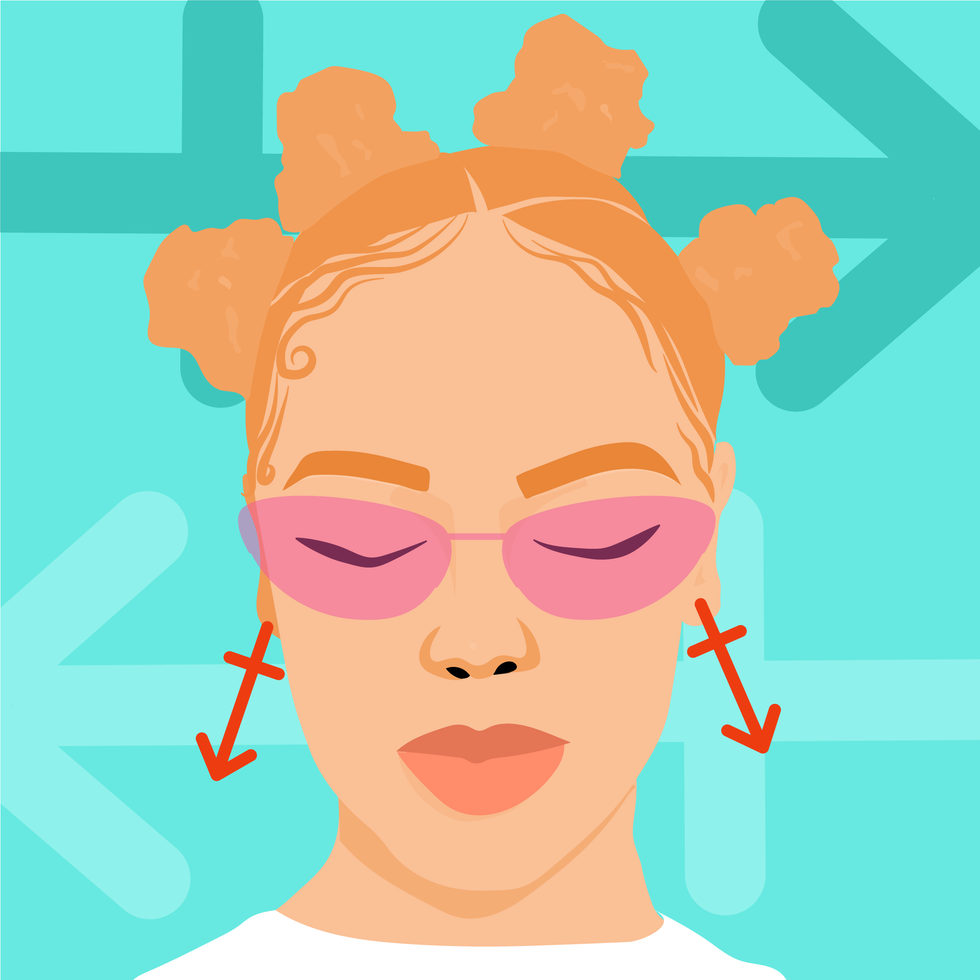 SagittariusKyra Jay for xoNecole
SagittariusKyra Jay for xoNecoleSAGITTARIUS
Sagittarius Season is here, and there is a lot in store for you this month, Sag. December is all about what you are dedicating yourself to. It’s about setting your intentions and putting the work in to back up your dreams, and about getting things in order so that when the new beginnings come, you are ready for them. The Sun and Venus are in your sign for most of this month, and there are a lot of eyes on you right now. You have the potential to create a new beginning for yourself, and it’s time to invest in yourself, your love life, and your dreams.
Mercury moves into Sagittarius on December 11, and this is giving you another opportunity to see through some of the plans that you had initiated in November. Mercury was retrograde in your sign last month, and there may have been some disruptions to your vision and plans for the future, and now this energy is turning around for you. Before the month ends, we also have a New Moon in Sagittarius, and you are walking through new doors fearlessly. You are catching others by surprise by your growth this month, and you are thinking a lot about your purpose, future, and plans for the new year.
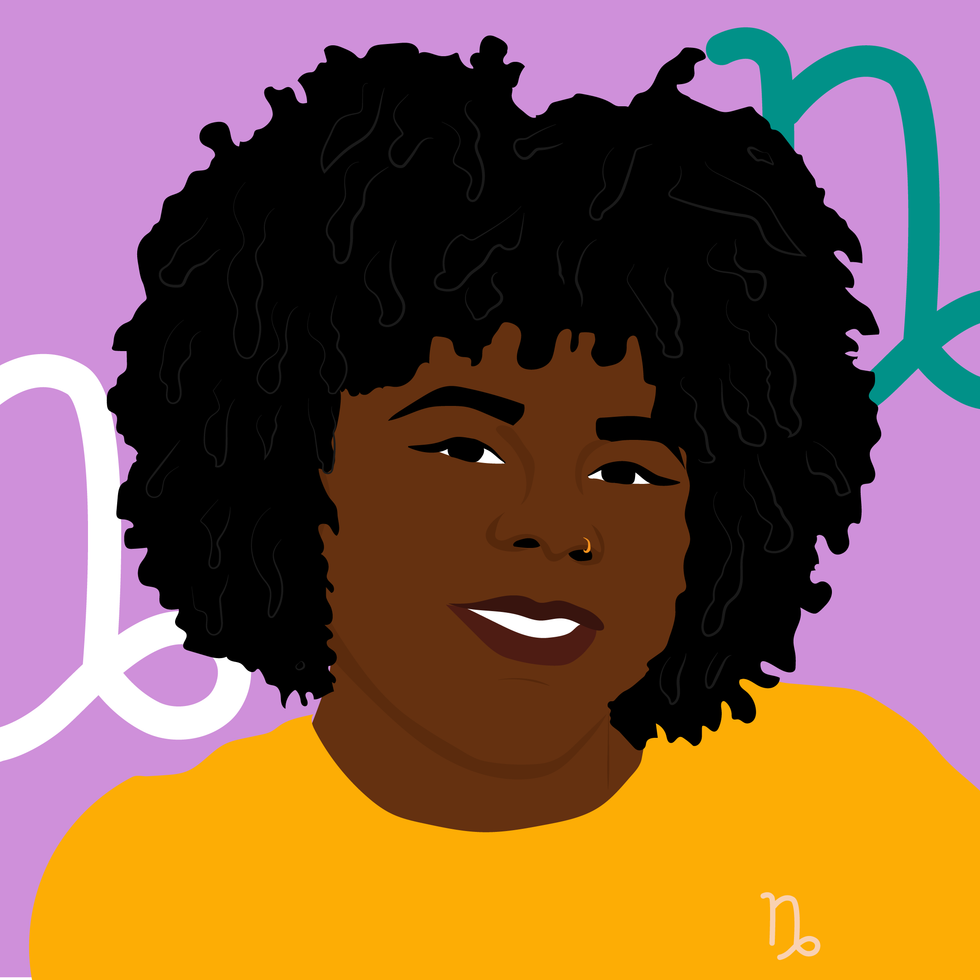 CapricornKyra Jay for xoNecole
CapricornKyra Jay for xoNecoleCAPRICORN
December is all about the vision, Capricorn. You are moving through a lot of changes and transformations this month, yet they are giving you a chance at a new beginning in the process. You are focused more on the future and what goals you want to manifest for yourself right now, and are ready to let go of what hasn’t been working for you. With the Sun in your 12th house of closure for most of December, this is your time for healing, but remember, healing doesn’t have to be isolating or boring; you can thrive while you renew, and you are this month.
Mid-month, the excitement picks up for you, and you are feeling more energized than you have in a while. Mars moves into Capricorn until the end of January 2026, and you are being proactive with your goals, intentions, and passions. You are a force to be reckoned with this month, and you are making things happen for yourself with confidence. Capricorn Season officially begins on December 21 this year, and this is definitely speeding up your healing process. You are breaking free from what was, and with Venus also moving into Capricorn before the month ends, you are leaving this year in high spirits and with love opening a new door for you.
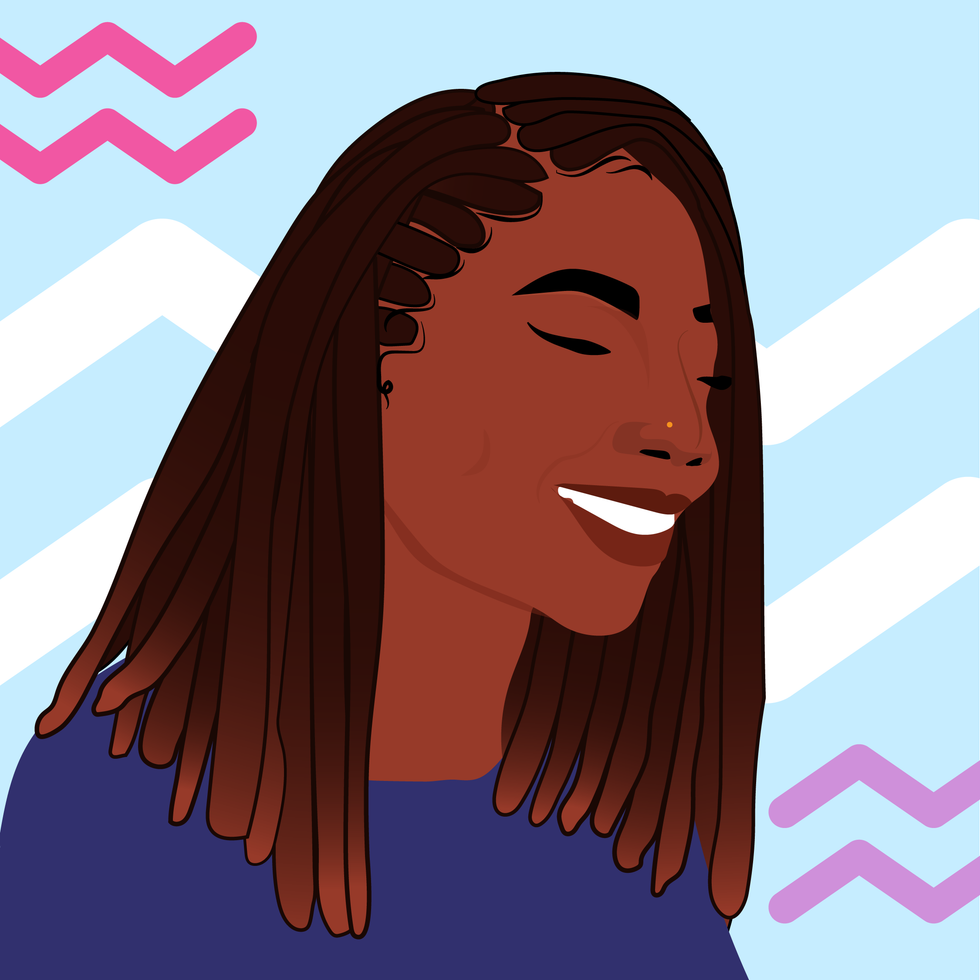 AquariusKyra Jay for xoNecole
AquariusKyra Jay for xoNecoleAQUARIUS
December is all about community, creativity, and manifestation, Aquarius. This is the month to work together with others to help bring your dreams to life. You are in a space of inspiration, empowerment, and beauty, and are creating more of this energy around you and in your world. Look out for what support comes your way this month and know that you don’t have to do everything alone to succeed. With the Sun in your 11th house of manifestation and friendship, your intentions are coming to fruition, and it’s time to celebrate with the people you love and to own how far you have come this year.
On December 19, we have a New Moon in Sagittarius, lighting up your life in all of the best ways possible. This is your New Moon of freedom, victory, and magic, and you are seeing new beginnings appear that you were once just hoping for. Before the month comes to an end, Venus moves into your 12th house of closure, and after an active and successful month, you are ready to relax, heal, and give your heart some of the attention it has been asking for. You are moving into the new year with the need to release and renew what hasn’t been working in your relationships, and you are finally ready to.
 PiscesKyra Jay for xoNecole
PiscesKyra Jay for xoNecolePISCES
December is a big month for you, Pisces. You are making some huge accomplishments this month, and are feeling like everything you have been through this year has been worth it for these moments that are coming to fruition for you now. The Sun is in your 10th house of career and reputation for most of the month, and this is where a lot of your focus is right now. You are claiming your successes and putting yourself out there in ways that not only serve you, but that inspire others as well.
Neptune officially goes direct on December 10, after being retrograde in your sign since July, and you are finally seeing things a little more clearly. You are feeling renewed inspiration and passion in your life, and your intuition is your strongest asset right now. Before December comes to an end, we also have a New Moon in your 10th house of career, and what happens now not only changes things for you in the present, but it also opens new doors and what is possible for you in the new year as well. Overall, you are on top of your game this month and are owning the joy and empowerment you feel.
Featured image by Kyra Jay for xoNecole
Don Benjamin On New Projects, Family & How He And His Wife Healed After Public Split
Actor and model Don Benjamin continues to expand in his career while also being a present husband and father. We first learned of the model in 2013, competing on America's Next Top Model Cycle 20, and now he's starring in major films like the recent Jordan Peele movie HIM and Adopted 2.
He was even the leading man in Cardi B's latest music video "Safe," which also features Kehlani. In an exclusive xoNecole interview, Don opens up about his family and this phase in his life.
"Honestly, the funny thing is, it's just like any other phase," he admits. "I just focus on work and growth and leveling up. I'm super excited about this moment because now, I'm finally tapping more into my acting side of stuff." He also shows off his acting skills on social media. Don, along with his wife, Liane V, often shares cute family skits on their respective Instagram and TikTok pages.
The couple share two kids, 2-year-old daughter Zaia Sky and Zaiden, who they had in June 2025. According to Don, Zaia is already following in his footsteps. "She's already doing more modeling jobs than me as of lately, and we want to get her in some acting. She loves the camera," he says. "It'll be nice to see if she follows in my footsteps, and I can kind of help line some things up for her."
Don and Liane have been married for four years, but had a very public breakup the year before. The Scared Famous star reveals how they did the work to heal and move forward together.
"We had our time to separate and work on self-growth, things that I needed to do for myself as a man, and working with life coaches and therapists, and she got the time to do what she needed to do. So when we came back together, we were in the right space mentally. We got a relationship coach that we can go through things with and talk about and work on and these things were important for us. Now, over the years, I feel like that actually helped us come closer together. That moment helped us come closer together."
"We had our time to separate and work on self growth, things that I needed to do for myself as a man, and working with life coaches and therapists, and she got the time to do what she needed to do. So when we came back together, we were in the right space mentally."
He continues, "I did what I had to do to understand [that] as a man, I never really had any male guidance in my life. So it was able to align me with the right coaches and pastors and therapists and people that I needed to align with to work on things that I had been dealing with in life. Then she got the space that she needed as a woman to work on her independence.
"We came back together strong, and now we were able to get married in the right space. A lot of times, people jump into marriage when they're not fully healed or in the right headspace. So we were able to get married in that right space. For us, it's been a beautiful thing, and we're able to use that as as an example."
Don also believes it's important to set an example for their kids, especially when it comes to love and respect. While the actor grew up without his dad, he has made it his priority to instill love in his kids by showing up for them and giving them words of affirmations.
As far as what's next for Don, he is starring and executive producing a paranormal activity film titled, holySmoke. "I'm loving the drama and horror space right now," he says.
"I always love a good romantic comedy, but right now. I seem to be getting reeled into all these horror films and thrillers and dramas."
Let’s make things inbox official! Sign up for the xoNecole newsletter for love, wellness, career, and exclusive content delivered straight to your inbox.
Feature image Nikita Melvil

